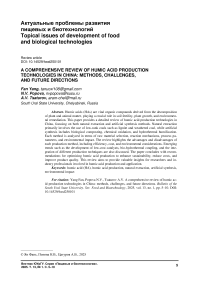A comprehensive review of humic acid production technologies in China: methods, challenges, and future directions
Автор: Yang Fan, Popova N.V., Tsaturov A.V.
Рубрика: Актуальные проблемы развития пищевых и биотехнологий
Статья в выпуске: 1 т.13, 2025 года.
Бесплатный доступ
Humic acids (HAs) are vital organic compounds derived from the decomposition of plant and animal matter, playing a crucial role in soil fertility, plant growth, and environmental remediation. This paper provides a detailed review of humic acid production technologies in China, focusing on both natural extraction and artificial synthesis methods. Natural extraction primarily involves the use of low-rank coals such as lignite and weathered coal, while artificial synthesis includes biological composting, chemical oxidation, and hydrothermal humification. Each method is analyzed in terms of raw material selection, reaction mechanisms, process parameters, and environmental impact. The review highlights the advantages and disadvantages of each production method, including efficiency, cost, and environmental considerations. Emerging trends such as the development of low-cost catalysts, bio-hydrothermal coupling, and the integration of different production techniques are also discussed. The paper concludes with recommendations for optimizing humic acid production to enhance sustainability, reduce costs, and improve product quality. This review aims to provide valuable insights for researchers and industry professionals involved in humic acid production and application.
Humic acid (ha), humic acid production, natural extraction, artificial synthesis, environmental impact
Короткий адрес: https://sciup.org/147247985
IDR: 147247985 | УДК: 658.788.462+547.458.1 | DOI: 10.14529/food250101


